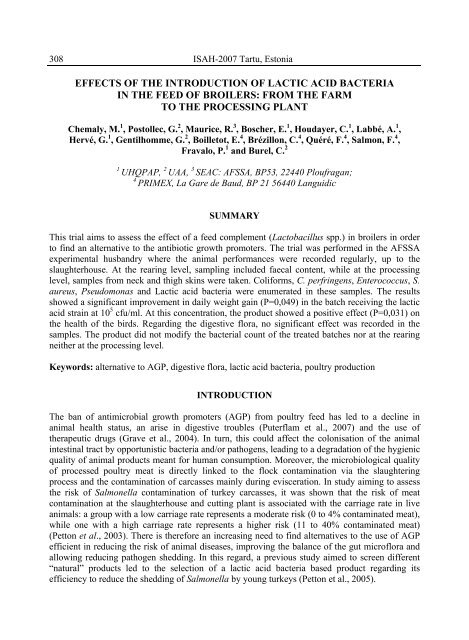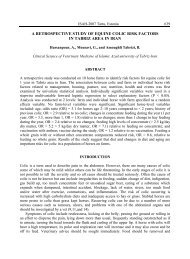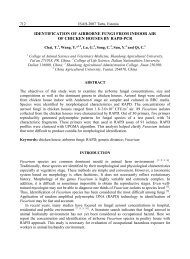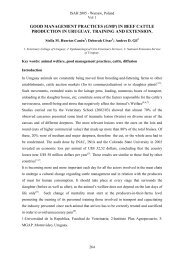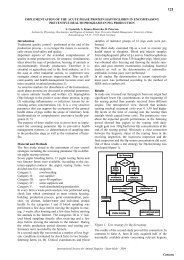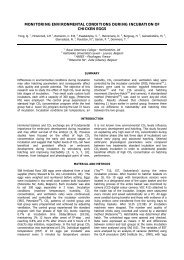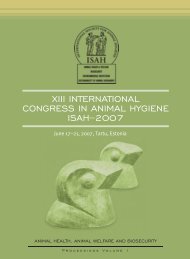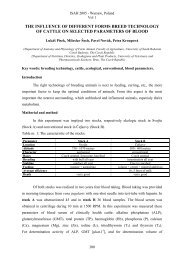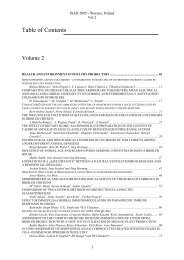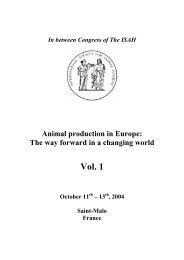EFFECTS OF THE INTRODUCTION OF LACTIC ACID ... - ISAH-SOC
EFFECTS OF THE INTRODUCTION OF LACTIC ACID ... - ISAH-SOC
EFFECTS OF THE INTRODUCTION OF LACTIC ACID ... - ISAH-SOC
Create successful ePaper yourself
Turn your PDF publications into a flip-book with our unique Google optimized e-Paper software.
308<br />
<strong>ISAH</strong>-2007 Tartu, Estonia<br />
<strong>EFFECTS</strong> <strong>OF</strong> <strong>THE</strong> <strong>INTRODUCTION</strong> <strong>OF</strong> <strong>LACTIC</strong> <strong>ACID</strong> BACTERIA<br />
IN <strong>THE</strong> FEED <strong>OF</strong> BROILERS: FROM <strong>THE</strong> FARM<br />
TO <strong>THE</strong> PROCESSING PLANT<br />
Chemaly, M. 1 , Postollec, G. 2 , Maurice, R. 3 , Boscher, E. 1 , Houdayer, C. 1 , Labbé, A. 1 ,<br />
Hervé, G. 1 , Gentilhomme, G. 2 , Boilletot, E. 4 , Brézillon, C. 4 , Quéré, F. 4 , Salmon, F. 4 ,<br />
Fravalo, P. 1 and Burel, C. 2<br />
1<br />
UHQPAP, 2 UAA, 3 SEAC: AFSSA, BP53, 22440 Ploufragan;<br />
4<br />
PRIMEX, La Gare de Baud, BP 21 56440 Languidic<br />
SUMMARY<br />
This trial aims to assess the effect of a feed complement (Lactobacillus spp.) in broilers in order<br />
to find an alternative to the antibiotic growth promoters. The trial was performed in the AFSSA<br />
experimental husbandry where the animal performances were recorded regularly, up to the<br />
slaughterhouse. At the rearing level, sampling included faecal content, while at the processing<br />
level, samples from neck and thigh skins were taken. Coliforms, C. perfringens, Enterococcus, S.<br />
aureus, Pseudomonas and Lactic acid bacteria were enumerated in these samples. The results<br />
showed a significant improvement in daily weight gain (P=0,049) in the batch receiving the lactic<br />
acid strain at 10 5 cfu/ml. At this concentration, the product showed a positive effect (P=0,031) on<br />
the health of the birds. Regarding the digestive flora, no significant effect was recorded in the<br />
samples. The product did not modify the bacterial count of the treated batches nor at the rearing<br />
neither at the processing level.<br />
Keywords: alternative to AGP, digestive flora, lactic acid bacteria, poultry production<br />
<strong>INTRODUCTION</strong><br />
The ban of antimicrobial growth promoters (AGP) from poultry feed has led to a decline in<br />
animal health status, an arise in digestive troubles (Puterflam et al., 2007) and the use of<br />
therapeutic drugs (Grave et al., 2004). In turn, this could affect the colonisation of the animal<br />
intestinal tract by opportunistic bacteria and/or pathogens, leading to a degradation of the hygienic<br />
quality of animal products meant for human consumption. Moreover, the microbiological quality<br />
of processed poultry meat is directly linked to the flock contamination via the slaughtering<br />
process and the contamination of carcasses mainly during evisceration. In study aiming to assess<br />
the risk of Salmonella contamination of turkey carcasses, it was shown that the risk of meat<br />
contamination at the slaughterhouse and cutting plant is associated with the carriage rate in live<br />
animals: a group with a low carriage rate represents a moderate risk (0 to 4% contaminated meat),<br />
while one with a high carriage rate represents a higher risk (11 to 40% contaminated meat)<br />
(Petton et al., 2003). There is therefore an increasing need to find alternatives to the use of AGP<br />
efficient in reducing the risk of animal diseases, improving the balance of the gut microflora and<br />
allowing reducing pathogen shedding. In this regard, a previous study aimed to screen different<br />
“natural” products led to the selection of a lactic acid bacteria based product regarding its<br />
efficiency to reduce the shedding of Salmonella by young turkeys (Petton et al., 2005).
<strong>ISAH</strong>-2007 Tartu, Estonia 309<br />
The aim of this study is to test the effect of this lactic acid bacteria based product regarding the<br />
growth performances and the digestive flora equilibrium balance during the rearing and the<br />
influence on the microbiological quality of the carcasses at the processing level.<br />
MATERIAL AND METHODS<br />
Animals<br />
5000 “Ross” broilers were divided into 15 batches distributed over 3 experimental treatments.<br />
Each treatment was replicated five times with 250 animals in each floor pen leading to a stocking<br />
density of 16 animals/m 2 .<br />
Lactic complement<br />
The lyophilised lactic acid bacterial strain was added to the drinking water. The birds of the<br />
treatment 1 (T1) received 10 5 cfu/ml, and those of the treatment 2 (T2) received 10 6 cfu/ml, while<br />
in the control treatment (T0); the animals did not receive the product.<br />
Animal performances<br />
Animal growth performances were recorded by weighing a sample of 30 animals by floor pen at<br />
7, 21 and 36 days. Feed intake and feed efficiency of each floor pen were estimated from the<br />
difference between the total quantity of feed distributed and the weight of the remaining feed at 7,<br />
21 and 36 days.<br />
Microbiological analyses<br />
For the study of the digestive flora, 15 animals from each treatment (3 per floor pen) were<br />
euthanized for faecal content sampling in order to follow the amount of total coliforms, C.<br />
perfringens, Enterococcus and Lactic acid bacteria at the rearing level. At the processing plant<br />
level, 15 samples of each treatment were taken from neck and thigh skins. On these samples,<br />
thermophilic coliforms, S. aureus, Pseudomonas and Lactic acid bacteria were enumerated the<br />
day of slaughter. After 7 days chilling at 4°C Pseudomonas and Lactic acid bacteria were<br />
enumerated on neck skins.<br />
Statistical analyses<br />
The effects of the feed complement were tested using when possible the parametric test Anova<br />
followed by Tukey’s test. When the conditions of normality and homogeneity of the variances are<br />
not completed, the non parametric test of Kruskall-Wallis was performed followed by Mann and<br />
Whitney’s test in case of significant differences between the treatments<br />
RESULTS<br />
Growth performances<br />
The administration of the lactic product did not show any significant effect (p=0.698) between 0<br />
and 7 days on the daily weight gain (DWG): the control and treated animals presented a DWG<br />
around 19 g/animal/day (table 1). Between 7 and 21 days, animals treated with 10 5 cfu/ml showed<br />
a significant higher DWG (p=0.090) than the other animals. Despite the lack of statistical
310<br />
<strong>ISAH</strong>-2007 Tartu, Estonia<br />
signification, treated animals with 10 6 cfu/ml had a higher DWG than the control ones (table 1).<br />
During the last rearing period, between 21 and 36 days, all the animals receiving or not the<br />
product had a similar DWG: about 88 g/animal/day. Finally, the lactic product had a significant<br />
beneficial effect (p=0.049) on the final body weight of the animals, but only at the dose of 10 5<br />
cfu/ml: 2255g for T1, while 2235g for T2 and 2216g for T0.<br />
Table 1. Animal daily weight gain (DWG) expressed in g/animal/day<br />
Treatments 0–7 days 7–21 days 21–36 days<br />
T0 (control) 19.5 ± 0.4 51.5 ± 1.6 (a) 87.9 ± 2.4<br />
T1 (10 5 cfu/ml) 19.1 ± 1.0 53.6 ± 1.1 (b) 88.6 ± 1.5<br />
T2 (10 6 cfu/ml) 19.2 ± 0.5 52.7 ± 1.0 (ab) 88.1 ± 2.5<br />
NS (p=0.698) S (p=0.090) NS (p=0.932)<br />
Reported values (mean ± standard deviation; n=5) have been statistically analysed using the test of Kruskall-<br />
Wallis followed by Mann and Whitney’s test. S: significant (p0.05)<br />
The treatment by the lactic product did not significantly affect either the feed gain ratio (FGR)<br />
(table 2), nor the feed consumption.<br />
Table 2. Animals feed gain ratio (FGR)<br />
Treatments 0–7 days 7–21 days 21–36 days<br />
T0 (control) 1.15 ± 0.03 1.46 ± 0.03 1.79 ± 0.09<br />
T1 (10 5 cfu/ml) 1.17 ± 0.03 1.41 ± 0.04 1.76 ± 0.08<br />
T2 (10 6 cfu/ml) 1.15 ± 0.04 1.44 ± 0.01 1.78 ± 0.05<br />
NS (p=0.756) NS (p=0.137) NS (p=0.779)<br />
Reported values (mean ± standard deviation; n=5) have been statistically analysed using the test of Kruskall-<br />
Wallis followed by Mann and Whitney’s test. S: significant (p0.05)<br />
Health status<br />
In general, no major health problem did occur during the rearing period except a short term<br />
diarrhoea which appeared at the beginning of the rearing. A non typable Escherichia coli was<br />
found in the faeces in the same period. A visual analysis has been realised over 50 chicks per floor<br />
pen based on the distinction between spoiled animals from clean ones in order to estimate the<br />
number of animals which contracted the diarrhoea (table 3). The statistical analysis showed that<br />
the number of animals treated by 10 5 cfu/ml was significantly lower (p=0.031) than the number of<br />
animals from the other treatments (table 3).<br />
Table 3. Diarrhoea observed on chicks at the beginning of the rearing period<br />
Treatments<br />
T0 (control)<br />
T1 (10 5 cfu/ml)<br />
T2 (10 6 cfu/ml)<br />
Diarrhoea (% spoiled chicks)<br />
22 ± 13 (a)<br />
8 ± 8 (b)<br />
22 ± 8 (a)<br />
S (p=0.031)<br />
Reported values (mean ± standard deviation; n=5) have been statistically analysed using the test of Kruskall-<br />
Wallis followed by Mann and Whitney’s test. S: significant (p0.05)
<strong>ISAH</strong>-2007 Tartu, Estonia 311<br />
MICROBIOLOGICAL ANALYSIS<br />
At the rearing level<br />
The treatment by the lactic product did not affect the bacterial count of lactic acid bacteria, total<br />
coliforms, Enterococcus and C. perfringens as no significant differences have been observed<br />
between control and treated animals at any sampling period (table 4). However, there is a<br />
significant effect of the rearing period on the means of bacterial count. In general, for all the<br />
microorganisms studied, the lowest count was noted between 7 and 21 days of rearing (table 4).<br />
Table 4. The means of bacterial count in animal faeces (log (10) cfu/g).<br />
Microorganisms Treatments 0–7 days 7–21 days 21–36 days<br />
T0 (control) 9.2 ± 0.6 7.7 ± 0.5 9.3 ± 0.3<br />
Lactic acid<br />
T1 (10 5 cfu/ml) 9.2 ± 0.6 7.7 ± 0.6 9.2 ± 0.4<br />
bacteria<br />
T2 (10 6 cfu/ml) 9.1 ± 0.4 7.9 ± 0.4 9.3 ± 0.6<br />
P=0.739<br />
T0 (control) 8.4 ± 0.4 7.5 ± 0.6 7.9 ± 0.6<br />
Total coliforms*<br />
T1 (10 5 cfu/ml) 8.0 ± 0.4 7.6 ± 0.6 7.8 ± 0.7<br />
T2 (10 6 cfu/ml) 8.0 ± 0.5 7.6 ± 0.6 7.8 ± 0.6<br />
P=0.501<br />
T0 (control) 8.4 ± 0.4 7.5 ± 0.6 7.9 ± 0.6<br />
Enterococcus spp.<br />
T1 (10 5 cfu/ml) 8.0 ± 0.4 7.6 ± 0.6 7.8 ± 0.7<br />
T2 (10 6 cfu/ml) 8.0 ± 0.5 7.6 ± 0.6 7.8 ± 0.6<br />
P=0.746<br />
T0 (control) 4.2 ± 1.9 3.2 ± 1.2 5.0 ± 1.5<br />
C. perfringens<br />
T1 (10 5 cfu/ml) 4.2 ± 0.5 2.5 ± 1.7 2.9 ± 2.1<br />
T2 (10 6 cfu/ml) 4.0 ± 1.2 2.2 ± 1.0 4.1 ± 1.9<br />
P=0.057<br />
Reported values (mean ± standard deviation; n=15) have been statistically analysed using the test of<br />
Kruskall-Wallis or the *Anova where the conditions of normality and homogeneity of variances were<br />
achieved. S: significant (p0.05)<br />
At the processing level<br />
The animals from our experimental rearing have been slaughtered at the beginning of the process<br />
in order to avoid cross contamination with animals coming from other farms. The day of<br />
slaughtering (d36), the lactic product, had no effect on the counts of the microorganisms studied<br />
on neck skins taken from control and treated animals (table 5). The mean counts of lactic acid<br />
bacteria, Pseudomonas and thermophilic coliforms were 5, 3.7 and 4 log(10) respectively.<br />
Table 5. The means of bacterial count on neck skins (log(10) cfu/g) the day of the slaughtering<br />
(d36).<br />
Treatments Lactic acid bacteria Pseudomonas spp. Thermophilic coliforms<br />
T0 (control) 5,1 ± 0,4 3,8 ± 0,4 4,4 ± 0,8<br />
T1 (10 5 cfu/ml) 5,1 ± 0,3 3,8 ± 0,3 4,3 ± 0,6<br />
T2 (10 6 cfu/ml) 5,1 ± 0,3 3,7 ± 0,5 4,2 ± 0,5<br />
p=0.997 p=0.947 p=0.755<br />
Reported values (mean ± standard deviation; n=15) have been statistically analysed using the test of Anova
312<br />
<strong>ISAH</strong>-2007 Tartu, Estonia<br />
The same analysis was done on thigh skins taken from control and treated animals (table 6). No<br />
significant effect of the lactic product has been recorded except for the count of thermophilic<br />
coliforms (table 6); however, from a biological point of view, the difference between the<br />
concentrations was considered not significant. The mean counts of lactic acid bacteria,<br />
Pseudomonas, S. aureus and thermophilic coliforms were around 4, 3, 2 and 3 log(10)<br />
respectively. The comparison of bacterial counts on neck and thigh skins showed a higher level on<br />
neck skins for the same microorganisms (tables 5 and 6).<br />
Table 6. The means of bacterial count on thigh skins (log(10) cfu/g) the day of the slaughtering<br />
(d36)<br />
Treatments Lactic acid bacteria Pseudomonas spp. S. aureus Thermophilic coliforms<br />
T0 (control) 4.9 ± 0.3 3.3 ± 0.6 2.2 ± 0.3 3.9 ± 0.4<br />
T1 (10 5 cfu/ml) 4.6 ± 0.3 3.1 ± 0.5 2.3 ± 0.3 3.7 ± 0.3<br />
T2 (10 6 cfu/ml) 4.9 ± 0.3 3.3 ± 0.3 2.4 ± 0.4 4.4 ± 0.4<br />
P=0.180 P=0.197 P=0.266 P=0.000<br />
The samples from thigh skins have been chilled at 4°C for 7 days (d43) in order to check the<br />
effect of the lactic product during the storage on the level of lactic acid bacteria and<br />
Pseudomonas. No significant effect of the lactic product was observed on the counts of lactic acid<br />
bacteria and Pseudomonas (table 8). At d43, the level of lactic acid bacteria decreased by about<br />
0.5 log(10) compared to the level at d36 (tables 6 and 7). Nevertheless, the average count of<br />
Pseudomonas increased significantly from 3log(10) at d36 to 7log(10) at d43 (tables 6 and 7).<br />
Table 8. The means of bacterial count on thigh skins (log (10) cfu/g) 7 days after chilling at 4°C<br />
(d43).<br />
Treatments Lactic acid bacteria Pseudomonas spp.<br />
T0 (control) 4.3 ± 0.4 6.9 ± 0.4<br />
T1 (10 5 cfu/ml) 4.4 ± 0.32 6.6 ± 0.5<br />
T2 (10 6 cfu/ml) 4.5 ± 0.2 7.2 ± 0.4<br />
P=0.468<br />
P=0.146<br />
DISCUSSION<br />
The growth performance of the chicken showed a significant effect, the lactic product added to<br />
the drink water at the dose of 10 5 ufc/ml (T1) compared to the control. However, no significant<br />
beneficial effect on the growth performance was observed at the dose of 10 6 ufc/ml (T2). The<br />
drinking water seemed yellowish at this higher dose, and it is likely that this high bacterial<br />
concentration altered the water quality, acting in turn on the intestinal flora of the birds and so on<br />
their growth performance.<br />
If the lactic product at the dose of 10 5 ufc/ml improves the growth of the chickens, it seems<br />
that it improves also their health status. Indeed, even if a single opportunistic visual observation<br />
was made, it seems that the intake of this dose of the lactic product protected the birds against a<br />
short-time diarrhoea likely caused by a strain of E. coli at the beginning of the rearing period. The
<strong>ISAH</strong>-2007 Tartu, Estonia 313<br />
visual observation indicated a lower proportion of animals affected by the diarrhoea and this<br />
protection could be related to the keeping of the balance of the intestinal flora.<br />
The treatment had no effect on the studied digestive flora counts (lactic acid bacteria, total<br />
coliforms, Enterococcus and C. perfringens). In a same way, no significant effect between control<br />
and treated animals has been observed during the rearing period. The decrease in bacterial count<br />
at the period 7–21 days could be due to the changes in feed composition corresponding to feed<br />
transition periods.<br />
At the processing level, the day of the slaughtering, the product had no effect on the level of<br />
the studied microorganisms (lactic acid bacteria, thermophilic coliforms, Pseudomonas and S.<br />
aureus) nor on neck skins neither on thigh skins as the comparison between control and treated<br />
animals showed no significant differences. During the storage period (7 days at 4°C) the product<br />
did not indirectly inhibit the growth of Pseudomonas on thigh skins as the level of these<br />
microorganisms was higher than the level the day of the slaughtering.<br />
We conclude therefore that the lactic acid based product did not disturb the digestive flora<br />
tested during this trial and had no effect on the microorganisms recovered on neck and thigh skins<br />
at the processing levels. The benefit on Salmonella carriage reduction at the end of the rearing<br />
period in conventional herd condition will be performed.<br />
REFERENCES<br />
Grave K., Kaldhusdal M., Kruse M., Fevang Harr L.M., Flatlandsmo K. 2004. What has happened in<br />
Norway after the ban of Avoparcin? Consumption of antimicrobials by poultry. Prev. Vet. Med. 62, 59–<br />
72.<br />
Petton, J., Allo, J.C., Boscher, E., Bourbao, G., Chemaly, M., Fravalo, P., Gillard, M.O., Laisney, M.J.,<br />
Lalande, F., Le Nôtre, Y., Nagard, B., Quéguiner, M., Quéguiner, S., Toquin, M.T. et Salvat, G., 2003.<br />
Evaluation qualitative et quantitative du risque à l'abattage et la découpe d'un lot de dindes porteur de<br />
Salmonella spp à l'élevage. Journées de la Recherche Avicole, 5, 453–456.<br />
Petton J., Chemaly M., Lalande F., Allo J.C., Fravalo P., Salvat G. 2005 Effet curatif de principes non<br />
antibiotiques sur le portage de Salmonella par des dindonneaux Journées de la Recherche Avicole, 6,<br />
455–458.<br />
Puterflam J., Grontec E., Derel R., Pinsard J.L., Martin D., Léorat J. 2007. Les entérites non spécifiques du<br />
poulet de chair: indicateurs, leviers de maîtrise. Journées de la Recherche Avicole, 7, 304–308.


